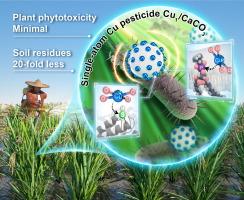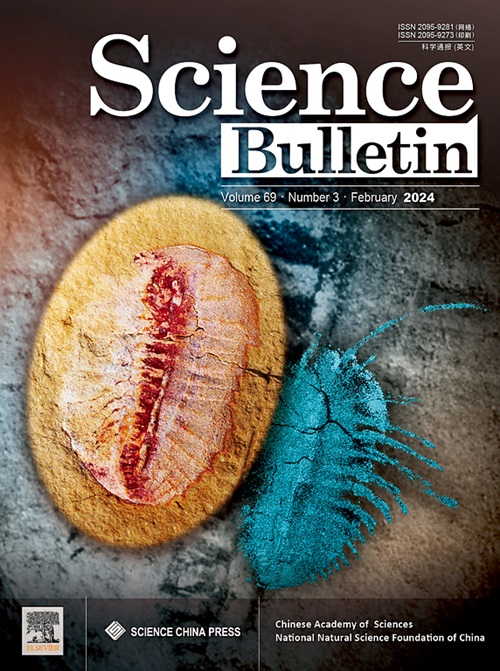一种铜基单原子材料,能有效防治植物病害,土壤残留几乎为零,植物毒性低。
IF 21.1
1区 综合性期刊
Q1 MULTIDISCIPLINARY SCIENCES
引用次数: 0
摘要
不断增长的人口要求发展可持续农业,这就要求在农药投放、施肥等方面实现原子经济。为此,我们将重点放在单原子材料(sam)上,以提高农业系统中的原子利用率。在这项研究中,我们报告了一种新的植物农药,单原子铜(Cu1)配方,采用沉淀平衡驱动(ksp驱动)方法将Cu1锚定在碳酸钙(CaCO3)载体上。由于其高原子分散性和利用效率,Cu1/CaCO3配方(Cu1/CaCO3)显著提高了作物的抗病性,同时对被试物种表现出最小的植物毒性。值得注意的是,与传统的铜配方相比,该配方在田间施用后土壤中的铜残留量减少了近20倍。它通过与膜磷脂中的磷酸基团(- po42 -)相互作用以及与呼吸链蛋白中的巯基(- sh)残基结合,潜在地靶向细菌膜的关键成分,从而抑制微生物的生长。Cu1/CaCO3代表了SAMs作为设计绿色农药来管理作物病害的一种有前途的工具和促进可持续农业的一种新的跨学科方法。本文章由计算机程序翻译,如有差异,请以英文原文为准。

A copper-based single-atom material effectively controls plant diseases with nearly zero soil residue and low phytotoxicity
A growing population necessitates the development of sustainable agriculture, which requires achieving atom economy in pesticide delivery, fertilization, and so on. To this end, we focus on single-atom materials (SAMs) to enhance atom utilization within agricultural systems. In this study, we report a novel pesticide for plants, a single-atom copper (Cu1) formulation, by employing a precipitation-equilibrium-driven (Ksp-driven) method to anchor Cu1 onto a calcium carbonate (CaCO3) carrier. Thanks to its high atom dispersion and utilization efficiency, the Cu1 formulation (Cu1/CaCO3) significantly enhances crop disease resistance while exhibiting minimal phytotoxicity in the tested species. Notably, this formulation leads to nearly 20-fold less copper residue in the soil after field application compared to traditional copper formulations. It inhibits microbial growth potentially by targeting key bacterial membrane components through interactions with phosphate groups (–PO42–) in membrane phospholipids and binding to sulfhydryl (–SH) residues in respiratory chain proteins. Cu1/CaCO3 represents SAMs as a promising tool for designing green pesticides to manage crop diseases and a novel interdisciplinary approach to promoting sustainable agriculture.
求助全文
通过发布文献求助,成功后即可免费获取论文全文。
去求助
来源期刊

Science Bulletin
MULTIDISCIPLINARY SCIENCES-
CiteScore
24.60
自引率
2.10%
发文量
8092
期刊介绍:
Science Bulletin (Sci. Bull., formerly known as Chinese Science Bulletin) is a multidisciplinary academic journal supervised by the Chinese Academy of Sciences (CAS) and co-sponsored by the CAS and the National Natural Science Foundation of China (NSFC). Sci. Bull. is a semi-monthly international journal publishing high-caliber peer-reviewed research on a broad range of natural sciences and high-tech fields on the basis of its originality, scientific significance and whether it is of general interest. In addition, we are committed to serving the scientific community with immediate, authoritative news and valuable insights into upcoming trends around the globe.
 求助内容:
求助内容: 应助结果提醒方式:
应助结果提醒方式:


